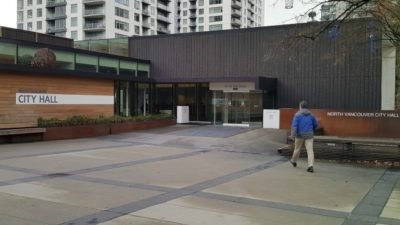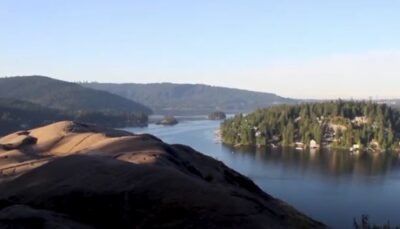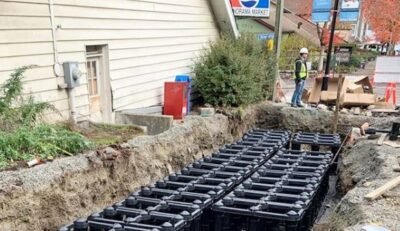North Vancouver City Council last year unanimously approved three transportation projects that are going to further destroy the ability to move efficiently and quickly across the City. And now on the back of the massive 3.98% unanimously approved tax increase, CNV is fast-tracking the following projects which will undoubtedly lead to additional ballooning tax increases in the coming years.
“Open Streets,” “Vision Zero” and “Safe Mobility” on the surface sound like projects you’d like to back and should. Who wouldn’t want to have no one ever to get hit by a car ever again. These projects are now being moved forward under the group name of “Healthy Streets”, to go with City’s goal to be the “healthiest small City in the world” (a discussion for another day).

The goal of Vision Zero and these other plans may sound good in theory. However, when you dig deeper into the projects you might find the costs of achieving such a lofty goal as Vision Zero for example may not be what we should do or be moving forward with.
First, let’s be clear. In every aspect of life, government and business, there’s a cost-benefit analysis that should be done (usually not done when the Government is spending public money). Whether you are personally deciding a vacation or planning to receive a COVID-19 vaccine, you make an assessment of the costs or risks verses the benefit to you.
In Canada, health care is rationed to keep the cost “manageable” for the government. It takes about two years to get a knee or hip replacement not because we don’t have the surgery rooms or talented doctors and nurses to do the surgery; no, it’s to manage the cost of the health care budget. In fact, in some cases doctors struggle to do enough surgeries to keep up with their required credentials while hospital rooms sit empty. Courts in Canada have ruled and stated “people are dying because of wait times” in our healthcare system.
So when I talk about the “costs” I’m including the dollar costs as well as the human costs and how those will be affected with the implementation of these insidious programs. While each of these programs will have its own specific ways of screwing up the City, they will all affect each of us every day.
It seems government at all levels love to talk about life in Europe. In this case, North Vancouver Staffers and City Council love to use the example of Oslo in Norway as their particular beacon of hope when talking about Vision Zero. Vision zero in Oslo started back in 1990 and they didn’t accomplish their goal of “zero instances” until 2019 (this even though Staffers will like to tell you it took “only ten years”). The situation in Oslo was far different from it is in North Vancouver. Back in 1975 there were 41 deaths from traffic in Oslo. In 1990 they had brought that down to only 18 deaths. Of course, North Vancouver city has never seen anything close to these sorts of numbers. In fact, North Vancouver can go an entire year without a single person being killed by a motor vehicle.
Of course, even one death is horrible and tragic for everybody involved. But if we must substantially change the drivability of each of the roads in North Vancouver and the ability to move efficiently through the city, is it worth it? One way Oslo dealt with traffic through the city was to move it underground through a series of tunnels. There is no intention for that to happen in North Vancouver. However, City Council and City Staff are working on plans to fast-track these projects which will massively change the drivability of the City.
Think of Lonsdale without parking and potentially becoming a “walking only” street. Or think about narrower streets everywhere throughout the city, including residential areas. Streets curving and winding to slow traffic with speed bumps and more to stop you from being able to drive at a reasonable speed to get around.
Last summer we saw the fast-track introduction of some of the plans the city has for the Open Streets project. We saw St. Andrews and Ridgeway streets blocked off to traffic. They became pedestrian and biking areas only. The West side of Grand Blvd was closed to traffic and was made for bikes only as well. These highly unnecessary closures of perfectly good and drivable streets stop people from being able to access their homes properly and in future will create a dangerous scenario for homeowners as police and fire become less able to access these streets.
To quote Karen Magnusson, the head of the traffic Department, at North Vancouver City… She said last year at the council meeting when these projects were approved; “We want to make sure we’re creating a network of streets that will enable fire to move generally through some fire response corridors. We’ll ensure that every street has fire access and will certainly work closely with the Department when we’re implementing some of the measures… we want to create driver behavior that’s more in tune with what we want to see on that street.”
What is she saying exactly? It’s like I said above. Narrower, slower-moving streets throughout the City. And she admitted that many of these streets would impair emergency vehicles from rapid response. She has a “vision” of what “driver behavior” should be and she’s going to make sure you comply! But hey, who needs the fire department or ambulance to arrive quickly in an emergency as long as we have “Healthy Streets?”
It’s important to understand that some of these measures have been implemented now for several years. Items like pedestrian bulges which have insidiously snarled traffic around the city while doing nothing to help with pedestrian safety.
We have never had a major issue with cars hitting pedestrians as was happening in Oslo. However, for some reason, years ago the City Staff thought it important to implement these bulges because at some conference that was attended they heard “the science is absolute”, as I was told by the traffic head.
To clarify, these pedestrian bulges are at corners and narrow the distance a pedestrian must walk in order to cross to the other side. I don’t know about you, but my mother taught me how to cross the street. Look both ways, make eye contact with the driver before you proceed. No bulge required. These bulges do more then just narrow the passage for the pedestrian. They have the effect of shooting a cyclist out into traffic making it a danger for the biker. Additionally, they cause the traffic to back up when a person is turning left and the person behind would like to turn right but cannot because of the bulges in the way. Further these bulges have cost millions of dollars over several years now and were again fast-tracked during the Covid-19 outbreak as you could see the pace of them being installed rapidly increased.
The problem the Staffers have is that they are working from a flawed model of prioritizing transportation types. There are several reasons they do this, not the least of which is that they have fallen into a “group-think” mentality that creates problems when presented ideas are taken as “proven science”. If a particular idea works well in Oslo or some other city in the world, it doesn’t mean it’s right for North Vancouver. However, that’s the approach.
The broken model is one that priorities the modes of transportation. Pedestrians first, then bikes, transit, commercial traffic and last cars. Having a model that makes you plan a City with these priorities is going to create the problems of traffic congestion as we’ve seen worsen over the years. The $750,000 of taxpayer money received by CNV from the Federal Government to study why congestion is so bad in the City is a big joke in my opinion. All you need to do is look at the decisions made by Staff and Council to understand the traffic problem.
The correct model is one that gives equal weight to each of the modes of transportation with the mandate that each should be able to move efficiently and safely throughout the City with as little stagnating interaction as possible. Doing this wouldn’t limit bike lanes or pedestrian pathways, although it might move them off many of the main streets where cars and transit flow. Doing this would also not require the removal of traffic lanes. As I said, when the City is working from a flawed model, you’re going to come up with bad decisions.
The Staff is responsible for bringing to the Council this flawed model and plans. However, this Council is ultimately responsible for asking very very few questions or even questioning the need for such drastic measures as are detailed in the plans I’ve mentioned above.
It’s important that you make your voice known that we do not want these plans to move forward – AT ALL. We must let Council know that if these plans go ahead we won’t vote for them in the next election.
I could go on and write a significant essay on the problems that are being created by the City Staff and this Council by approving such horrible plans. But mark my words, each of these plans will create further traffic problems in CNV. If these plans continue, the city will never be the same and moving easily through the city in a car electric or otherwise will become worse, very difficult and annoying at best.
Tony Neumeyer has lived most of his life on the North Shore, and is interested and involved in local civic issues. Views expressed in this column are his own and may not necessarily reflect those of this publication.









Could not have said it better myself. Thank-you to Tony Neumeyer for going to bat for some common sense out of City Hall when it comes to streets/traffic design and planning. Wasting tax dollars to solve non existent problems or worse yet the creation of new safety issues where previously there weren’t any! – i.e. traffic bulges that have pedestrians standing closer to traffic – absolute nonsense, and when that heavy truck ’rounds the corner – well it’s like a trap laid, and heaven help the poor soul who gets snared. Road humps on bus routes – total stupidity. No right turns on a red?? come on City, what is your true agenda?
To me, the end game for the City seems to be all about making the use of the personal auto completely in-efficient. Those with the keys to the traffic department boardroom must hate cars, why? I don’t think they know why, it’s just an in-vogue thing and they are going with it. That the majority of the community requires a vehicle with four wheels, a roof and a trunk matters not to these bureaucratic zealots who count the spokes on their bicycle wheels as a means to fall asleep with.
But seriously, the pursuit of traffic gridlock as a goal under the guise of a so called healthy, live-able city seems ill thought and one-sided. As I started out saying, a big dose of common sense and a community that plans for all we should not only expect, but require.
I respectfully disagree with this whole analysis. Similar improvements have been introduced successfully in cities all over the world, not just in Oslo, and tend to be quite popular once experienced. Oslo has 15 times the population of N. Vancouver, so arguing that the number of crashes is low compared to Oslo doesn’t say much. A drunk driver killed a woman in N. Vancouver just last month. Vision Zero street design can prevent crashes even by irresponsible drivers. Vancouver-area hospitals take in victims of traffic crashes all the time; it is a top source of patients in their trauma wards. Traffic deaths are the #1 cause of death for young Canadians. Many others are left permanently maimed. Of course making traffic safer is worth it.
In the process, streets also become less frightening to people not in cars. That encourages walking, biking, e-biking, and all the other new light modes of transport that are emerging. They have a much lighter impact on the city than cars, with low emissions, less tire/asphalt carcinogens in the air, and less congestion, while the personal health benefits of active transportation are extremely well understood by now.
Things like curb extensions to shorten crossings are extremely helpful to the elderly trying to cross wide roads, as well as to people in wheelchairs, and parents pushing strollers. Drivers also tend to slow down near them, which is the point.
Over the decades cars have invaded every possible inch of public space in our cities. It’s time to take some of that space back and make the streets safe and comfortable for all users, not just people driving a ton or even two tons of steel around the streets even to run the nearest errands.
The National Association of City Transportation Officials (NACTO) is an association formed to exchange transportation insights and practices. It says:
“Curb extensions visually and physically narrow the roadway, creating safer and shorter crossings for pedestrians while increasing the available space for street furniture, benches, plantings, and street trees. They may be implemented on downtown, neighborhood, and residential streets, large and small.”
Bulges may slow my car travel by seconds, or even minutes, but I am OK with that if they create greater safety for children, slow-moving seniors or distracted individuals who momentarily forget rules for safe crossing.
Business friendly Bloomberg organization reported:
“The most obvious immediate benefit to a fundamentally slower city is the safety boost it delivers. Reducing speeds is the best, easiest, and fastest way to quickly radically improve safety, for both drivers and anyone in front of them. A recent report from the Insurance Institute for Highway Safety estimates that rising speed limits in the United States have led to an additional estimated 37,000 deaths over the past 25 years.
“’We know that very small changes in speed can have big consequences for pedestrians,’ says Jessica Cicchino, the vice president of research at IIHS. “A pedestrian struck at 25 miles per hour has 25 percent chance of being seriously injured—but that climbs to a 50 percent chance at 33 miles per hour.” Importantly, lower speed limits also reduce the number of crashes, as an IIHS study found last year in Boston after it lowered its default speed in 2017.”
Does anyone remember Dana Carveys SNL skit where he portrayed a grumpy old man? He speaks with gumshoe, the deeds of his youth. the times of back then, and how much simpler it was and knowing what was right. Not like these folks now-a-days…
I find so much of this article incorrect, and should he write an essay as mentioned it would be interesting if data from his points would be added or just opinions as above. “If these plans continue, the city will never be the same”, well yes, that is exactly the point. When it’s sunny and clear skies, it might get warm on ones face. Time moves only one way, in what we know of it beyond theories, but it remains constant in that one factor, it moves and never stops. What is life is it stops? There are many challenges to the Shore and across the water and the CNV is proving more open to design options than before because it’s a needed position for this time. Walk, Bike, scooter, drive, Hop skip and dance your way around, but petrol four wheel vehicles continuing to hold the fort of transportation is shifting, nothing will change that in this time.
The author is simply uninformed, misguided and have extreme poor knowledge and ideology based. While writing is full information and fake news. Its saf to see such a poorly written and bogus information is even published somewhere. Truly pathetic.